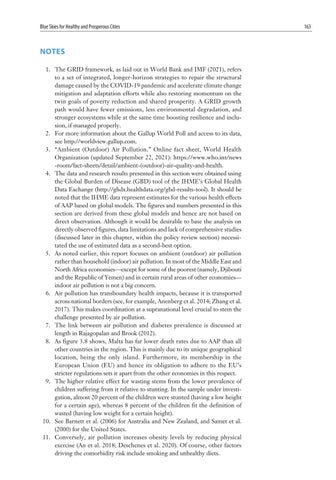Blue Skies for Healthy and Prosperous Cities
NOTES 1. The GRID framework, as laid out in World Bank and IMF (2021), refers to a set of integrated, longer-horizon strategies to repair the structural damage caused by the COVID-19 pandemic and accelerate climate change mitigation and adaptation efforts while also restoring momentum on the twin goals of poverty reduction and shared prosperity. A GRID growth path would have fewer emissions, less environmental degradation, and stronger ecosystems while at the same time boosting resilience and inclusion, if managed properly. 2. For more information about the Gallup World Poll and access to its data, see http://worldview.gallup.com. 3. “Ambient (Outdoor) Air Pollution.” Online fact sheet, World Health Organization (updated September 22, 2021): https://www.who.int/news -room/fact-sheets/detail/ambient-(outdoor)-air-quality-and-health. 4. The data and research results presented in this section were obtained using the Global Burden of Disease (GBD) tool of the IHME’s Global Health Data Exchange (http://ghdx.healthdata.org/gbd-results-tool). It should be noted that the IHME data represent estimates for the various health effects of AAP based on global models. The figures and numbers presented in this section are derived from these global models and hence are not based on direct observation. Although it would be desirable to base the analysis on directly observed figures, data limitations and lack of comprehensive studies (discussed later in this chapter, within the policy review section) necessitated the use of estimated data as a second-best option. 5. As noted earlier, this report focuses on ambient (outdoor) air pollution rather than household (indoor) air pollution. In most of the Middle East and North Africa economies—except for some of the poorest (namely, Djibouti and the Republic of Yemen) and in certain rural areas of other economies— indoor air pollution is not a big concern. 6. Air pollution has transboundary health impacts, because it is transported across national borders (see, for example, Anenberg et al. 2014; Zhang et al. 2017). This makes coordination at a supranational level crucial to stem the challenge presented by air pollution. 7. The link between air pollution and diabetes prevalence is discussed at length in Rajagopalan and Brook (2012). 8. As figure 3.8 shows, Malta has far lower death rates due to AAP than all other countries in the region. This is mainly due to its unique geographical location, being the only island. Furthermore, its membership in the European Union (EU) and hence its obligation to adhere to the EU’s stricter regulations sets it apart from the other economies in this respect. 9. The higher relative effect for wasting stems from the lower prevalence of children suffering from it relative to stunting. In the sample under investigation, almost 20 percent of the children were stunted (having a low height for a certain age), whereas 8 percent of the children fit the definition of wasted (having low weight for a certain height). 10. See Barnett et al. (2006) for Australia and New Zealand, and Samet et al. (2000) for the United States. 11. Conversely, air pollution increases obesity levels by reducing physical exercise (An et al. 2018; Deschenes et al. 2020). Of course, other factors driving the comorbidity risk include smoking and unhealthy diets.
163






